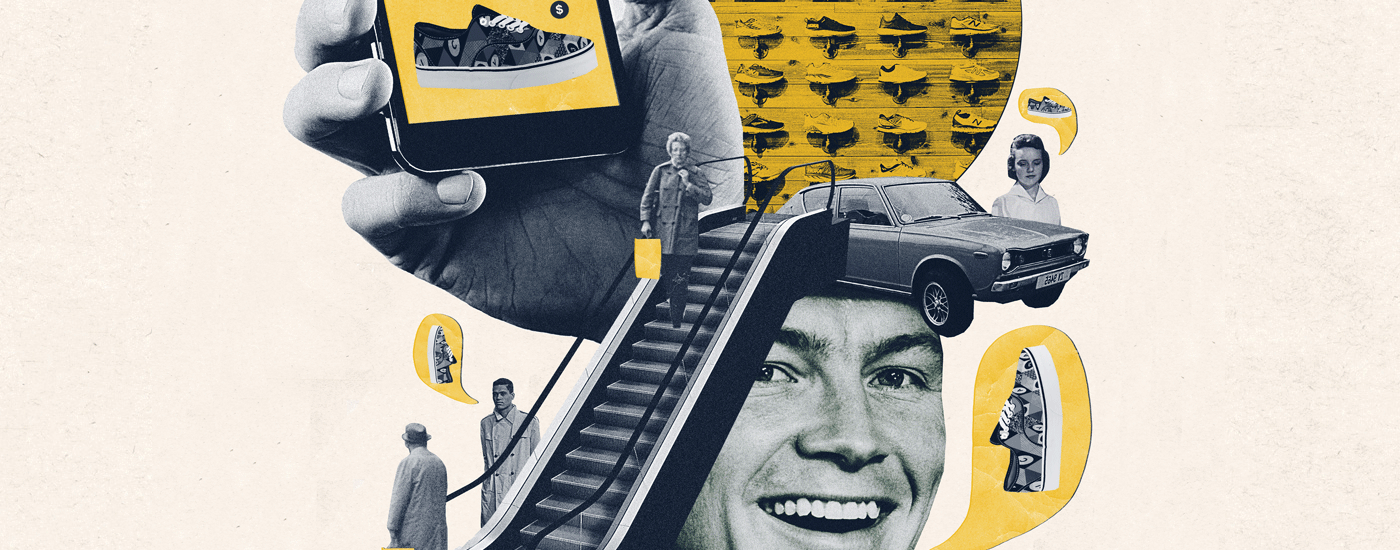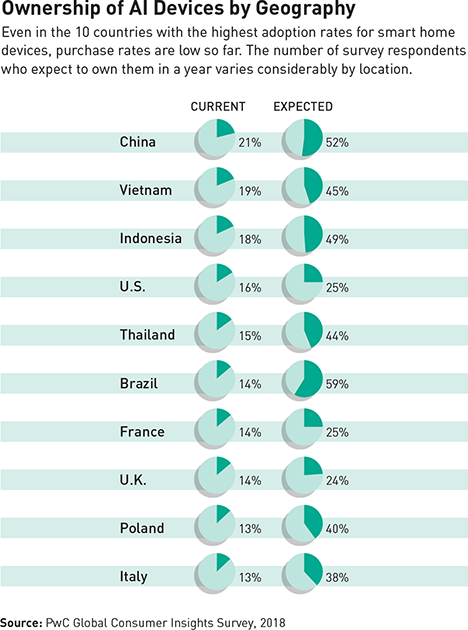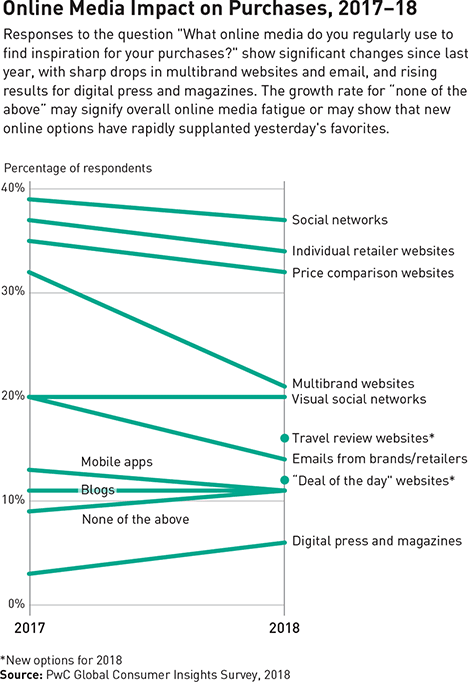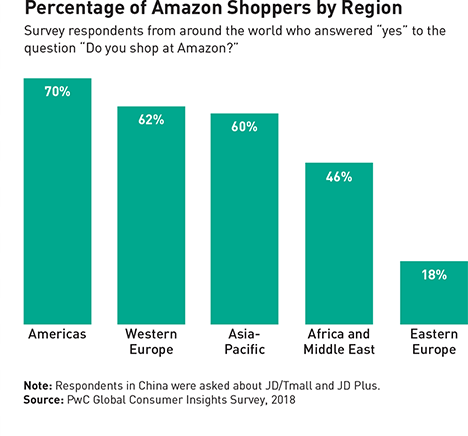Competing for Shoppers’ Habits
PwC’s seventh annual global survey of consumers suggests that the next major retail industry battle will be over control of everyday routines.

A version of this article appeared in the Summer 2018 issue of strategy+business.
The well-publicized difficulties of traditional retail enterprises were on our minds this year as we began sifting through the data from our annual PwC Global Consumer Insights Survey (GCIS), conducted in late 2017 and published earlier this year. For the seventh consecutive year, we asked people around the world about their shopping and consuming activities. This time, there were 22,000 respondents in 27 territories (26 countries plus Hong Kong). We imagined that we would end up telling a simple story about the bleak prospects for brick-and-mortar retail.
Not so fast.
As it turns out, GCIS respondents told us for the fourth year in a row that they have increased, not decreased, their shopping in physical stores. They’re also using mobile devices, especially smartphones, for more and more of their shopping. The survey paints a picture of retail patrons who are complex; conflicted; highly segmented by age, gender, and geography; and on the cusp of change — but not necessarily in the ways that most retailers expect.
For example, respondents were asked to name shopping experiences that gave them satisfaction. Fifty-three percent named face-to-face interaction with knowledgeable, helpful salespeople — a larger percentage than those who named personalized offers (40 percent) or in-store screens that display product lines (39 percent). In general, when it comes to deciding where to shop, the choice of whether the venue is online or “in real life” matters less than a long list of other factors, including privacy and personalization. (That last point may be changing; some consumers are starting to feel unnerved by websites and devices that track their purchase histories and know too much about them.)
For consumer products companies and retailers seeking success, the most important factor to watch is the reshaping of consumer habits by new technologies and online social interaction. Everyday activities that have driven marketing strategies for decades — weekly grocery trips, spending a day at the shopping mall, “Black Friday”–style holiday shopping, coupon- and promotion-driven bargain hunting — are attracting fewer people every year. The traditional path to purchase is being replaced by a highly personalized consumer journey, enabled by smartphones, digital assistants, and other personal devices, and embedded in new forms of logistics such as curbside pickup and same-day delivery. In this new world, every product and brand is always accessible, information is limitless, variety is infinite, and delivery is nearly instantaneous. It’s not yet clear which shopping habits will catch on most widely, but those that do will heavily influence which brands people will buy and which retail and consumer products companies will succeed.
Already, these new habits are reflected in growing consumer loyalty to companies such as Amazon, Alibaba, Walmart, Apple, JD, and Inditex (known for its flagship brand, Zara). These are the e-tailers and retailers with the devices, formats, and shopping services that consistently provide exceptional value and variety with a minimum of friction or stress. It can easily become second nature to follow their paths of least resistance, which are designed to help consumers feel natural as they navigate a world of endless choices.
The new habits of today’s shoppers also cater to the high expectations people have today about the value of the products and services they purchase. Today’s consumers — particularly younger ones — are abandoning the deeply entrenched practice of “satisficing.” That was economist Herbert Simon’s term for shoppers’ tendency to settle for “good enough,” because physical access and insufficient information made it impossible to find the “absolute best.” No more; the new goal is maximizing rather than satisficing. These days, the absolute best often seems within reach.
As a result of these developments, many (but by no means all) consumer habits are being reshaped and replaced through a process that is well-known in neuroscience. For today’s shoppers, triggers of mental activity are always close by. Popular e-commerce portals, websites, and social media platforms have developed sophisticated ways to engender superior customer experience, drawing people in and inspiring their loyalty with gratification, value, dependability, and transparency. Repeated again and again, the resulting behavior becomes a routine. And as journalist Charles Duhigg points out in his book The Power of Habit (Random House, 2012), when people consistently repeat routines, the behavior can become automatic. The winners in the retail and consumer products industries will be the enterprises that best anticipate those new habits in advance, create experiences and offerings that invoke and reinforce them, and capitalize on the patronage of customers they have captured in this way.
Smartphones, Stores, and Social Media
Our global survey identified five key trends that tell us about the corresponding changes in consumer behavior and the opportunities they provide to producers and sellers of consumer goods and services. The first three are related to new technologies and the habits they engender.
1. Consumers now use smartphones as a routine shopping gateway. Handheld devices and wearable devices are becoming the portal of choice for the omnichannel shopping environment. Globally, the use of mobile phones for shopping has more than doubled in the past six years; 17 percent of our survey respondents said they used their cell phone to make daily or weekly purchases. This degree of usage is quickly approaching that of shopping via personal computers, which has been stuck at about 20 percent for the past five years.
Globally, the use of mobile phones for shopping has more than doubled in the past six years — quickly approaching that of shopping via personal computers.
The survey also detected what might become the next big trend: voice-assisted interactions for all kinds of needs, including shopping, through devices such as the Amazon Echo, Google Home, and Alibaba’s Genie. This type of device, first available in 2015, is now used by 6.8 percent of our survey respondents for frequent purchases and has surpassed smart watches, at 6.1 percent. In December 2017, Chain Store Age estimated that nearly one in five consumers had already made a voice purchase through an Amazon Echo or another automated personal assistant device during the past year, and another 33 percent said they planned to do so in the coming year.
Our own survey found slower rates of acceptance — so far. About 10 percent of our survey respondents said they already owned a voice-assisted device. Another 32 percent said they planned to buy one, and interest was highest in Brazil and China. What’s unclear is whether large numbers of consumers or high-value shoppers will develop a real Amazon Alexa or Google Assistant shopping habit, casually speaking up whenever they want a new grocery item, or whether the devices will end up simply used as enhanced on-demand music speakers and information sources.
More generally, the survey indicated that consumers in parts of Asia, China in particular, have adopted new technology of all kinds faster than have their Western counterparts. Only 16 percent of U.S. respondents said they used their mobile phones and smartphones for frequent purchases, compared with 52 percent of Chinese consumers. The percentage of consumers who plan to purchase a device with artificial intelligence (for example, a robot or an automated personal assistant such as Amazon Echo or Google Home) was twice as high in China as in the U.S. (see “Ownership of AI Devices by Geography”).
2. Shoppers haven’t given up on stores. Dire headlines about widespread store closings — particularly in the U.S., which is plagued with overbuilt retail space — should not be misinterpreted as a death knell for brick-and-mortar. Forty-four percent of survey respondents said they shopped in stores daily or weekly (for items other than groceries), up from just 36 percent in 2014. Indeed, despite more than 8,000 store closings in 2017, U.S. in-store revenues far exceeded expectations, with healthy year-over-year increases.
Some new e-commerce channels are, in fact, complementing their physical counterparts by integrating the analog and digital environments. Baidu and Yum Brands, for example, have launched a smartphone-based augmented reality (AR) app; customers earn meal discounts by scanning stickers that launch games and simulations on their devices. In the U.S., Lowe’s has been experimenting with virtual reality (VR): Its “holoroom” allows customers to visualize and plan major room redesigns. IKEA has a similar app that lets customers preview what furniture would look like in their own homes.
Some retailers, including Best Buy and Restoration Hardware, are experimenting with showrooming, offering the sensory benefits of in-store shopping without the cost of maintaining inventory. Customers physically encounter products in the store and then order them online. Bonobos, an online retailer of men’s clothing acquired by Walmart in 2017, has created small brick-and-mortar “guideshops” where customers make an appointment to come in, get fitted with the help of a personal guide, and then place an order online for home delivery from a warehouse. The London-based luxury e-tailer Farfetch has partnered with Gucci to launch F90, a service that allows shoppers in 10 cities around the world — including Los Angeles, Dubai, Tokyo, and São Paulo — to order items online and have them delivered from the local store within 90 minutes. The Amazon Go convenience store design has an automated purchase-tracking system in which cameras monitor and record every selection, plus app-enabled payment and no checkout registers.
The resilience of real-life shopping reminds us that it’s easier to augment and modify habits than to erase them. Not so long ago, experts predicted that e-books would cannibalize the market for printed books; today, printed books enjoy rising popularity, and e-book sales have leveled off. Our survey found that millennials were likely to shop in physical stores more frequently than older consumers, a finding confirmed by other studies. To be sure, there’s always the chance that a new technology could change habits rapidly. For example, just 16 percent of survey respondents said they were comfortable with the idea of delivery of any product by smart drones, but we expect that if drones develop a good track record, acceptance will increase.
3. Consumers are still migrating to social media. Consumers are drowning in choices. To make sense of the many options they have for purchases, they increasingly turn to people they know. Online, where experts abound, consumers pay more attention to social media, personal networks, and blogs than to branded publications. In some cases, they seem to trust the wisdom of the crowd: Many base their decisions on recommendation engines and comments from strangers. But it’s their personal crowd that matters most.
Specifically, when they were asked to name three online sources of inspiration for their purchases, 37 percent of the survey respondents cited social networks; 20 percent named visual social networks such as Snapchat and Instagram. More traditional sources included retailer websites (34 percent) and digital press and magazines (6 percent). Another PwC research report, the 2017 Holiday Outlook Survey, found that conventional TV advertising still has some compelling power. Its respondents said that TV advertising was, by far, the leading source of gift ideas. But the younger the target audience, the more essential it is for marketers to embrace and engage with social networks rather than traditional marketing and media tactics (see “Online Media Impact on Purchases, 2017–18”).
The reliance on social networks is more than twice as high in some Asian countries and the Middle East as in the U.S. and Western Europe. Distinct age and gender differences also appear. Generally speaking, women and younger people are more influenced by social networks, especially visual social networks, whereas older people and men pay more attention to price-comparison websites.
Suspicion and Trust
The last two noteworthy trends have to do with the relationships between the consumer and the retail enterprise, and the trust — or lack of it — that people feel.
4. Consumers feel vulnerable to digital malfeasance — but not enough to act. In August and September 2017, the PwC Consumer Intelligence Series (CIS, a research project conducted by PwC’s advisory marketing group) asked 2,000 U.S. consumers about privacy and cybersecurity risks, especially relating to retailers. This was in the wake of data-breach scandals such as the loss of personal information by Equifax. The survey found very low levels of trust: Only 25 percent of consumers felt companies handled their personal or financial data responsibly, and 15 percent felt companies would use that data to improve consumers’ lives. The public sector was even less trusted: 72 percent of the respondents said business was better equipped than government to protect them. Forty-five percent said they assumed their email or social media accounts would get hacked in the next year. And just 10 percent said they felt they had control over their personal information.
One might assume that this attitude would lead to a proactivity among consumers, and a keener interest in protecting themselves. We tested that hypothesis against results from the same CIS survey. Respondents were asked whether they were taking actions to protect their identity and accounts. Not many said yes; indeed, fewer did than the year before. Only 43 percent said they avoided clicking on pop-up ads, 36 percent said they used different passwords for different sites, and 34 percent said they minimized the amount and type of data they would give out.
In short, most consumers will still rely on retail companies to preempt security problems — presumably because of the complexity involved. There are clear opportunities for suppliers of new technology, such as blockchain, that could provide additional layers of security.
The one place consumers say they would act is in their choice of merchant: 87 percent said they would take their business elsewhere if they didn’t trust a company was handling their data responsibly. Of course, for companies doing business in the European Union — regardless of where they’re based — everything will change when the E.U.’s General Data Protection Regulation (GDPR) goes into effect on May 25, 2018. The GDPR’s strict new guidelines for protecting online consumers’ privacy will influence the extent to which companies seek permission before using people’s data for marketing or other purposes.
The GCIS survey results suggest that a slim majority of consumers will welcome constraints like those of the GDPR, even if it means sacrificing convenience for more privacy safeguards. The level of trust depends, in part, on what data is used for. About four in 10 said they were comfortable with e-tailers analyzing their personal shopping activity to provide highly relevant shopping tips and special offers. Around the world, however, many consumers seem to draw the line at GPS-enabled “proximity marketing,” which sends offers to their smartphones when they approach a store. Only three in 10 shoppers are comfortable with advertising based on tracking their location through their mobile phones and smart watches. The countries most suspicious of location-based marketing, as indicated by survey respondents, were Germany, Russia, Ireland, and the Netherlands.
In general, consumers want to be sure that no sensitive personal information is misused or breached. But they know they can’t be sure, and they appear to simply hope for the best. As Harvard Business Review reported in early 2018, consumers tend to base their trust or mistrust of retailers not on logic, but on emotional cues. For example, if a store’s tries to show responsiveness by disclosing information about customers that it has drawn from other websites, the customers may feel as if they are being talked about behind their backs. This tends to make them uneasy about posting their personal data. Retail and manufacturing brands will build trust by providing cues that lead consumers to feel that the company is on their side. This will extend to decisions about collaboration with search engines, devices, and social media platforms. The trust or suspicion inspired by their platforms could affect every retailer and consumer products company associated with them.
5. Consumers are increasingly loyal to the online mega-players. Through a dizzying kaleidoscope of alliances and acquisitions, multichannel retail mega-competitors are establishing a massive presence and building impressive consumer loyalty. According to our survey, 59 percent of consumers globally — up from 56 percent in 2016 — regularly shop with Amazon or, in China, its equivalents JD (owned by Tencent) and Tmall (owned by Alibaba). Those platforms are even more pervasive in big consumer markets; Amazon is used by 89 percent of survey respondents in the U.S., 90 percent in the U.K., 94 percent in Germany, and 96 percent in Italy (see “Percentage of Amazon Shoppers by Region”). In China, virtually everyone we surveyed (98 percent) uses JD or Tmall. The percentage of online customers who shop exclusively with these platforms — using JD and/or Tmall in China, or Amazon elsewhere — rose from 10 to 14 percent between the 2017 and 2018 surveys.
Our survey illustrates how successfully the giants are generating repeat business with customers through loyalty programs. Globally, 36 percent of Amazon’s customers already pay for Amazon Prime, the company’s premium subscription service. These Prime members told us the benefits they value most are unlimited free delivery; access to entertainment (films, music, books, TV, gaming); and exclusive deals. Amazon and its competitors are reshaping and reinforcing consumer habits every day by providing triggers, routines, and rewards in this way. Some big retailers, recognizing the success of their mega-multichannel competitors, are looking for new forms of shopping behavior they can capture first.
Capitalizing on Platforms and AI
The path to strategic opportunity lies in correctly anticipating new shopping habits and their implications. Of course, that’s easier said than done. Not all trends become habits. Just look at the once-bustling business of home-delivered meal kits, led by Blue Apron and HelloFresh. According to the Wall Street Journal, consumer interest peaked around 2015; one study showed that for 70 percent of customers, the novelty wore off after six months and they dropped out.
Voice-assisted home control devices are intended to become the hubs of retail platforms. In the emerging competition for consumer habits, each company hopes that its offering will eclipse the others and become the portal of choice for people seeking frictionless shopping (along with the management of other familiar tasks). As Scott Huffman, vice president of engineering for Google Assistant, told the Washington Post at the opening of the 2018 Consumer Electronics Show (CES), “You should have the same assistant helping you across all the contexts of your life.” Google, he added, is seeking to provide it. If consumers do indeed gravitate to one home shopping device, its producer would truly become the world’s most dominant retail enterprise.
But it’s not playing out that way so far. The producers of phones, speakers, TVs, and home appliances prefer to be “voice agnostic.” LG is offering a new TV, for example, which contains LG’s own voice-assisted remote control platform, ThinQ — but the units also support Google Assistant and Alexa. As the Internet of Things becomes more prevalent in connected households, products such as the new GE ceiling fan, which can be controlled by both Alexa and Google Assistant, are likely to proliferate.
In the meantime, our research and observations suggest some ways to navigate this new world, many of which have to do with finding one’s way among the platforms controlled by mega-retailers such as Amazon, Walmart/Jet, and Alibaba. Their continual expansion provides opportunities for smaller players and partners, especially those with powerful brands. For instance, Amazon and Calvin Klein experimented in 2017 with pop-up stores, featuring Alexa-enabled dressing rooms and offering some apparel exclusively on Amazon.
We’re also likely to see a shifting array of “frenemy”-style alliances among platform companies and companies with compelling brands. Peapod, combating new competition from Amazon’s acquisition of Whole Foods, announced a voice-activated platform in late 2017 called “Chat to Cart,” which expands the ways customers can order groceries online. Those include an app that can be downloaded for use with Alexa. In other words, Peapod is using Amazon’s voice platform to compete with Amazon’s food business. In the U.K., online supermarket Ocado is doing exactly the same thing.
If you want to make your mark in omnichannel consumer experience, the starting point is in the palm of your hand. The smart mobile devices consumers carry into stores are obvious tools for optimizing the features our survey respondents told us they appreciate most while shopping: easy navigation of the store and quick access to product availability, whether online or at another store. Smart mobile devices can convey all that, and much more. Even if proximity marketing makes people uncomfortable, many phone owners will opt in to location-based apps that trigger in-store activity in retail environments they trust: unlocking special offers, pointing the way to displays of particular interest, and interacting with in-store displays. Handheld software of this sort could give retailers a cost-effective alternative to expensive digital kiosks. It could also free up the time store associates spend answering inquiries, allowing them to focus on higher-value tasks.
The interest that consumers have in better information suggests that merchandise displays — whether in stores or on apps — will soon be more interactive. Many stores, such as Walmart, already have end caps with passive video displays. These will evolve into eye-catching personalized displays. A grocery shopper, scanning a store display with a phone, would see an app pop up with menus for the foods sold nearby, targeted to the individual’s preferences. Dressing rooms have already appeared at London fashion shows, on an experimental basis, that use VR and holograms to let people see how they’d look in a clothing item without actually trying it on. This type of device, once perfected, could further establish high-definition personalized experience as a means for enticing consumers into stores.
In general, we’re likely to see far more interaction between the phone and the store as smartphones, abetted by machine learning algorithms, begin anticipating needs rather than simply responding to commands. A shopper entering a store might be reminded by his phone that the towels he looked at online last week are available right now in aisle seven, and be offered a 20 percent discount. A phone might look at a consumer’s calendar while she’s at the supermarket and remind her that the kids will be home from college in a few days and she should pick up extra food.
Phone-enabled shopping will be one element of a broader emerging retail phenomenon: the AI personal shopper. Cloud-based platforms, interpreting data accumulated from multiple consumers, will allow even smaller retailers to surround individuals with a virtual extension of themselves that knows all about their shopping history, preferences, activities, and probable interests, and that has instant access to all the information available from retailers, goods producers, and service providers. AI will also be instrumental in providing a truly interactive in-store experience.
Already, retailers are using data analytics and machine learning to insert customized content on e-commerce sites. Buy a pair of Clarks desert boots on Amazon, and for weeks you will see ads across various websites for other boots and shoes. Before long, personal shoppers will become much more sophisticated. Promotions, products, pricing, graphics, and text will all be customized to people’s demonstrated preferences. Inevitably, some retailer will overreach and people will discover how invasive personalized messages can be. Within a few years, companies will find the appropriate balance, and people will come to see this type of personalization as appropriate and routine.
The payoff for many shoppers will be more effective bargaining power and faster, smarter choices. A consumer might say to Siri or Alexa, “Tell me about moderately priced elliptical machines,” and Alexa might hand her over to “Joe” — a voice-activated, video-on-demand virtual salesman created by Bowflex, NordicTrack, or possibly Dick’s Sporting Goods or Walmart. Using personal information the consumer shares, Joe could suggest which machines are best suited to her, demonstrate their use, provide comparison shopping, and then take an order and arrange delivery. The AI personal shopper would also keep track of the minutiae of commerce: digital receipts, warrantees, instruction manuals, and repair histories. This will add to the longevity of big-ticket purchases, and make it easier to maintain and upgrade them.
These findings are consistent with our firm’s in-depth research on the potential impact of AI, “Sizing the Prize,” published in 2017. Within retail, the greatest potential for AI impact lies in personalized design and production; prediction of customer behavior and personalization of offers; and inventory and delivery management, including roboticized warehouse loading and sophisticated delivery drones.
Emotionally Rich Experience
The survey responses make it clear that consumers are looking for emotionally satisfying connections with retailers large and small. This in part reflects the stress of shopping today. Bombarded by nonstop information from countless sources, and presented with an overwhelming array of options, consumers are constantly challenged in finding what they are looking for, and in getting value from their purchases. Retailers that can consistently help them do these things will capture their appreciation, trust, and loyalty.
In every country, online consumers find less of the guidance they seek through conventional advertising than from other sources. In 2017, CIS respondents were given a list of 25 organizations and asked which they trusted most. Marketing and advertising organizations came in dead last. Social media was typically first; in many cases, particularly in China, consumers paid less attention to celebrity endorsers than to “key opinion leaders.” These are people who educate themselves about a given category of goods or services, and then gain a loyal following based on their credibility. A company that is marketing in China and not paying attention to the key opinion leaders for its product categories is missing a crucial source of shopper inspiration.
In our more recent survey, the 2018 GCIS, we also found Chinese consumers, by and large, to be the earliest adopters of digital technology. They were more than three times as likely as their U.S. counterparts to use a smartphone for frequent shopping, and more than twice as likely to use a voice-controlled device or smart watch. By more than a three-to-one margin, Asian consumers said they were more likely to shop in stores that allowed mobile payments; Western European consumers were almost evenly split between those who said it was important and those who didn’t.
But in general, consumers around the world want the same things. They are increasingly “trust seekers”: If they are to have confidence in their merchants, they want a high level of transparency. This goes beyond tracking packages or checking up on price guarantees. They are interested in the company’s social responsibility and the degree to which it honors its commitments. For example, companies such as Sizzlefish, Sea to Table, and Harbour Trading provide home delivery of quality seafood from guaranteed sustainable sources; some even provide a bar code on the packaging that customers can scan with their phone to be linked directly to the captain and crew who caught their fish. The clothing retailer Everlane has a “radical transparency” philosophy that means it displays, for each item, the name and background information of the factory in which it was made as well as the cost of production and transport.
Consumers are also ever more interested in making emotional connections, particularly during the shopping experience. They relish the excitement that comes from making a discovery — a great new brand no one has heard of, a terrific new store, a wonderful out-of-the-way resort. For some people, particularly those in their 20s and 30s, a second jolt of satisfaction comes from posting the discovery online. Sharing their photos and celebrating their purchases — “Hey, look at this amazing dinner we’re having!” — has become ingrained in the way consumers think about shopping, and can be a key factor for businesses in building loyalty with them.
The Habit of Fostering Habits
Because of the fierceness of competition, the pace of change in this industry will almost certainly accelerate. Retailers cannot afford to move slowly. Consider what’s happened just since we conducted the survey in late 2017:
• At that time, Amazon was still working out the kinks of an experimental, checkout-free, phone-enabled convenience store. By January 2018, the first Amazon Go store had opened for business in Seattle.
• The future of Amazon Alexa was still uncertain then. But during the holiday season, 11 million of these devices were sold in the U.S. alone — bringing the annual total to 25 million — and voice-assisted technology dominated the 2018 CES in Las Vegas.
• The use of augmented reality in stores was a rarity. By early 2018, Apple had updated its ARKit augmented reality platform to include two-dimensional image recognition, and more than 2,000 apps were already available using ARKit features.
The lesson is clear: Most of the consumer habits people grew up with in the past needed years, even decades, to take shape. But they’re being reshaped and replaced at a frantic pace. As retail companies find they can no longer take old consumer habits for granted, established marketing practices such as trade promotion and television advertising will probably be forced to change. The companies will have to invent and cultivate new habits of their own, to match the new attitudes and predilections of their customers. For the next few years, life may be especially difficult for the retail industry, because it is not clear yet which new consumer habits will stick. If you’re a retailer, you may have to get into the practice of fostering new habits just to keep up with your changing customers. Bit by bit, the retail environment you create this way will evolve, until the only things that remain from the past are the human needs — for satisfaction, simplicity, safety, and emotional connection — that engendered all this change in the first place.
Author profiles:
- John Maxwell is the leader of PwC’s global consumer markets group. He is a partner with PwC US and is based in New York.
- Denise Dahlhoff is the research director of the Baker Retailing Center at the Wharton School of the University of Pennsylvania.
- Claire-Louise Moore specializes in market research with PwC Research, PwC’s global center of excellence for primary research and evidence-based consulting services. She is a manager with PwC UK, based in Belfast, Northern Ireland.
- Also contributing to this article were Mike Brewster, PwC marketing director for global retail and consumer industries, and contributing writer Mark Nadler.






